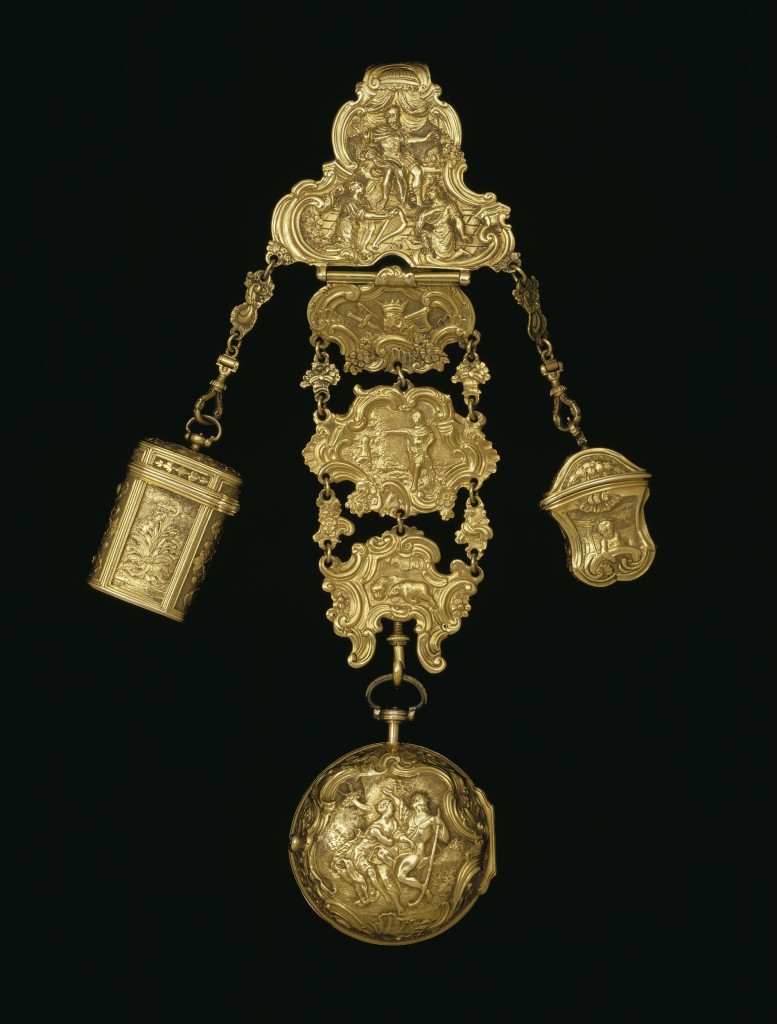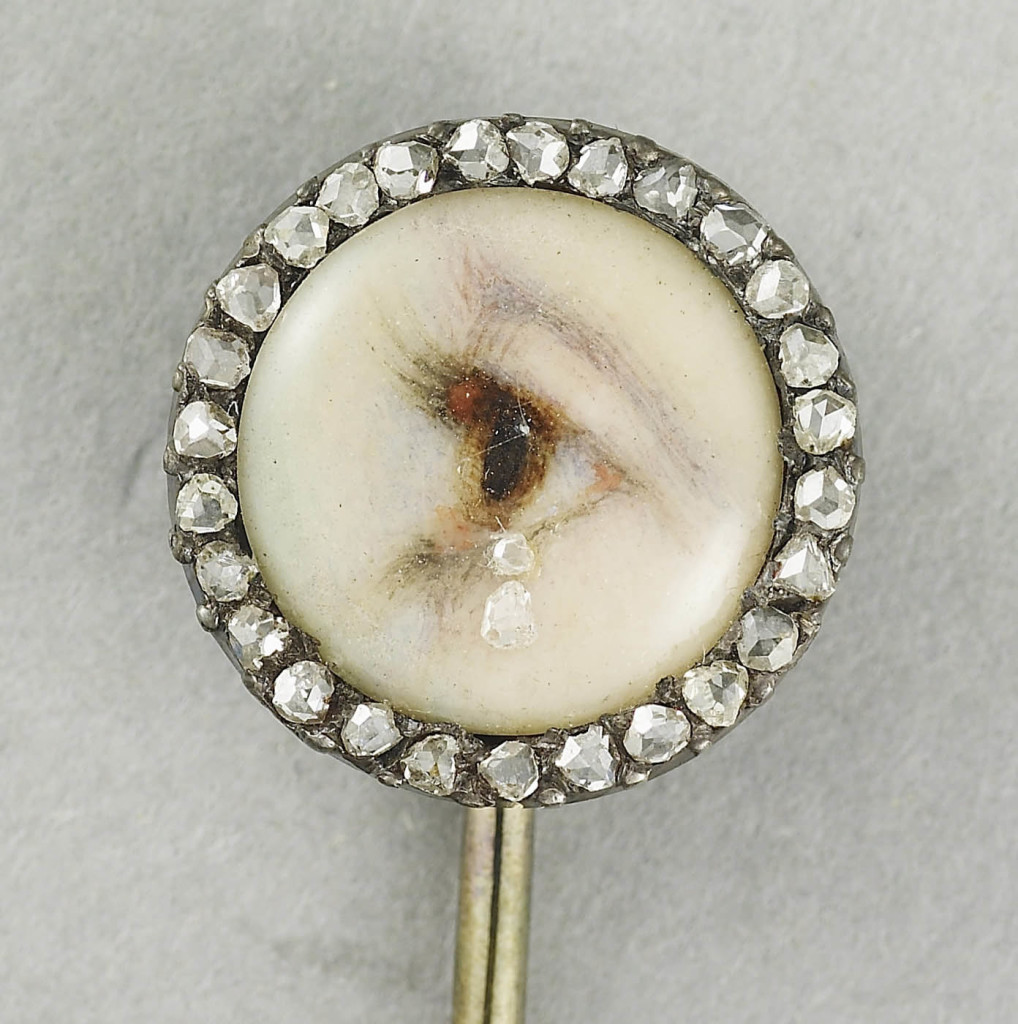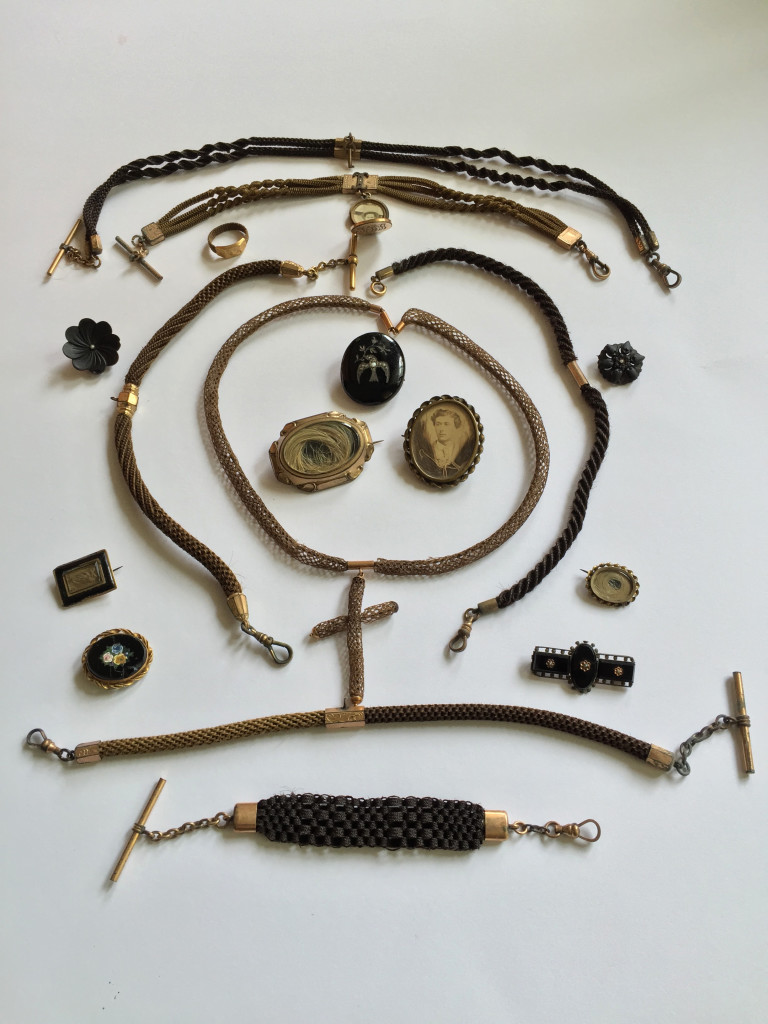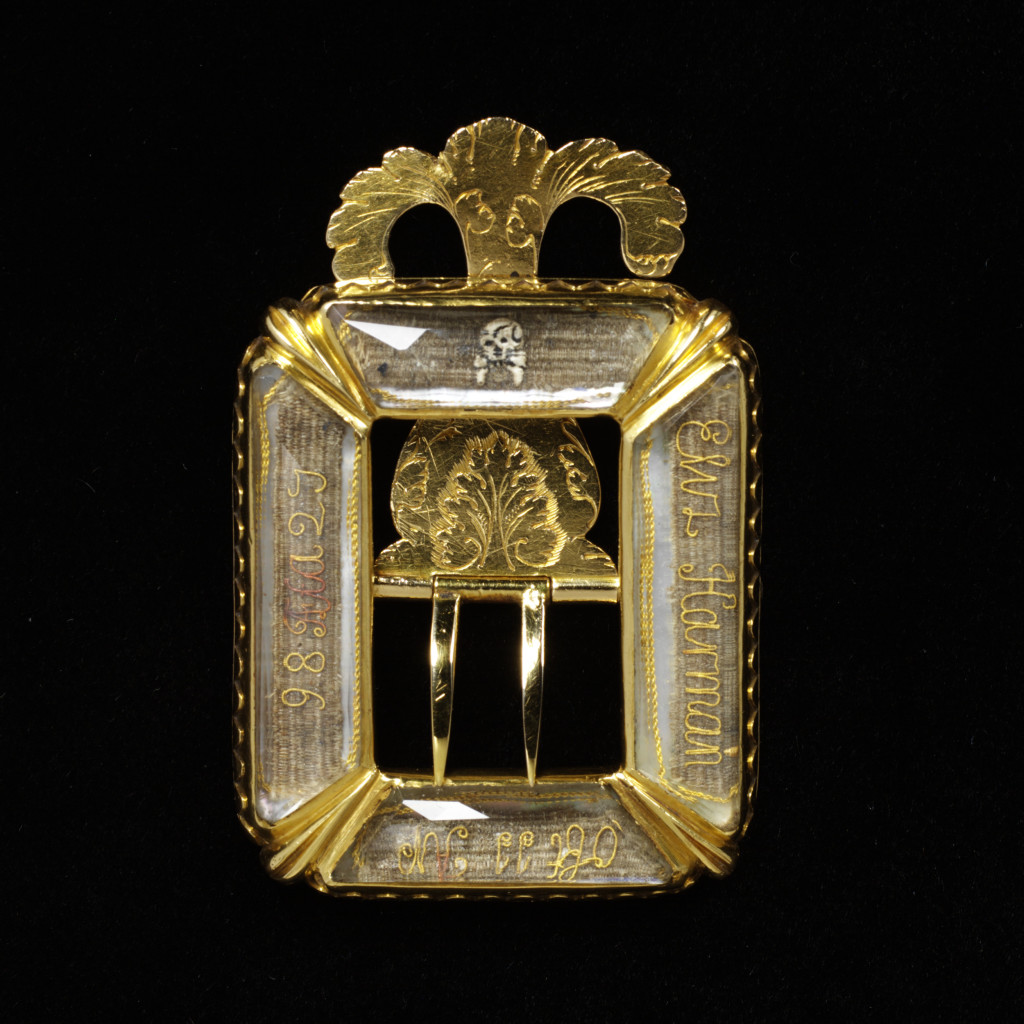The Chatelaine, Function and Sentimentality
Tokens of affection aren’t simply baubles that are transient, they are often useful accessories that hold a memory within their daily function. By the 18th century, there was enough development of production and industry to facilitate a working class and their objects of daily use. In this cut-steel and sepia chatelaine, the elements of love and remembrance come together with a useful item.
As written about with charms, chains are important to note for their ability to be functional and also sentimental. Predominantly worn outside clothing, their use in daily fashion is ancient. In modern mourning and sentimental jewels, they maintained their elements of functionality and meaning, allowing people to have a glimpse into the private life of an individual at work. This could be an alluring charm to denote status, or simply a requirement of daily life, which is what makes the chatelaine so important to a lady’s lifestyle.
A chatelaine is constructed from a hook-plate with around five to nine hanging chains. These chains have rings or catches to hold various daily household objects, such as keys, trinkets and other items of daily use. Affixed to a woman’s belt or girdle, the perception of wearing the chatelaine changed over time, from a symbol of status and wealth, to the holder being the domesticated keeper of the household.
As with any accessory that could be made into an element of high fashion, the chatelaine reached all levels of society with different materials and functions. In this gold example hallmarked for 1755/6, the chatelaine holds a watch and étuis (containers) and a watchkey. One étui is empty and the other was for snuff (containing a spoon), dating from c.1730. The watch has the name of the watchmaker, Robert Cawley, written inside, with scenes from the bible designed into the chatelaine and watchcase, combining scenes from the life of King David as described in the Bible. On the watchcase is a scene of Angelica and Medoro carving their initials in a tree, taken from the epic Orlando Furioso by the Italian poet Ludovico Ariosto (1474-1533).
Clearly the chatelaine is incredibly delicate in its nature and stands as a personal statement of variations in love and sentimentality.
“The hook plate of the chatelaine is cast and chased with a scene of David playing his harp before Saul. The three pendent plaques are chased and embossed. The plaque immediately below the hook plate is chased and embossed with a trophy centred on the head of Goliath. On the middle plaque, Jonathan directs a small boy to search for arrows beyond him, the warning he had agreed with David, if Saul remained angry; on the bottom plaque are the bear and lion killed by David as a shepherd. The smaller of the two étuis is chased with putti and scrollwork. The snuff étui contains a gold spoon, and is chased in a different style with foliage, birds, shell and strapwork.” – V&A Museum
When seen as an entire chain and watch combination, very element of its design works in tandem. The design of the watch conforms to the chatelaine, making it highly expensive and not at all random. It is eye-catching and quite a large accessory to be made of gold.
Cut-steel used in context of the chatelaine is both beautiful and functional. The strength of the metal, combined with daily use, make this a perfect marriage in ornamental function. A housekeeper could use a device like this on a daily basis and not worry about excessive damage.
‘The production of cut-steel ornaments appears to have first started in Woodstock near Oxford in the early 1600s. By the 1760s it had spread to other English cities, including London and Birmingham. Cut steel became popular on the Continent as well. It was not only used as a cheap substitute. The inventory made after the death of the French Empress Josephine in 1814 also included two suites of cut-steel jewellery.
Cut steel continued to flit in and out of fashion throughout the 19th century. It was produced in Paris in small quantities until the 1940s.” – British Museum
Cut-steel popularity grew in the 18th century, during a time in c.1759, when Louis XV requested that the French donate their gems and gold to fund the Seven Years War, quite similarly to the ‘Berlin Iron’ jewels. Cut-steel, as with any jewels that are an approximation of precious metals and gems, are faceted in a way to reflect the light using a method called ‘chip carving’, cutting away metal with a chisel and hammer.
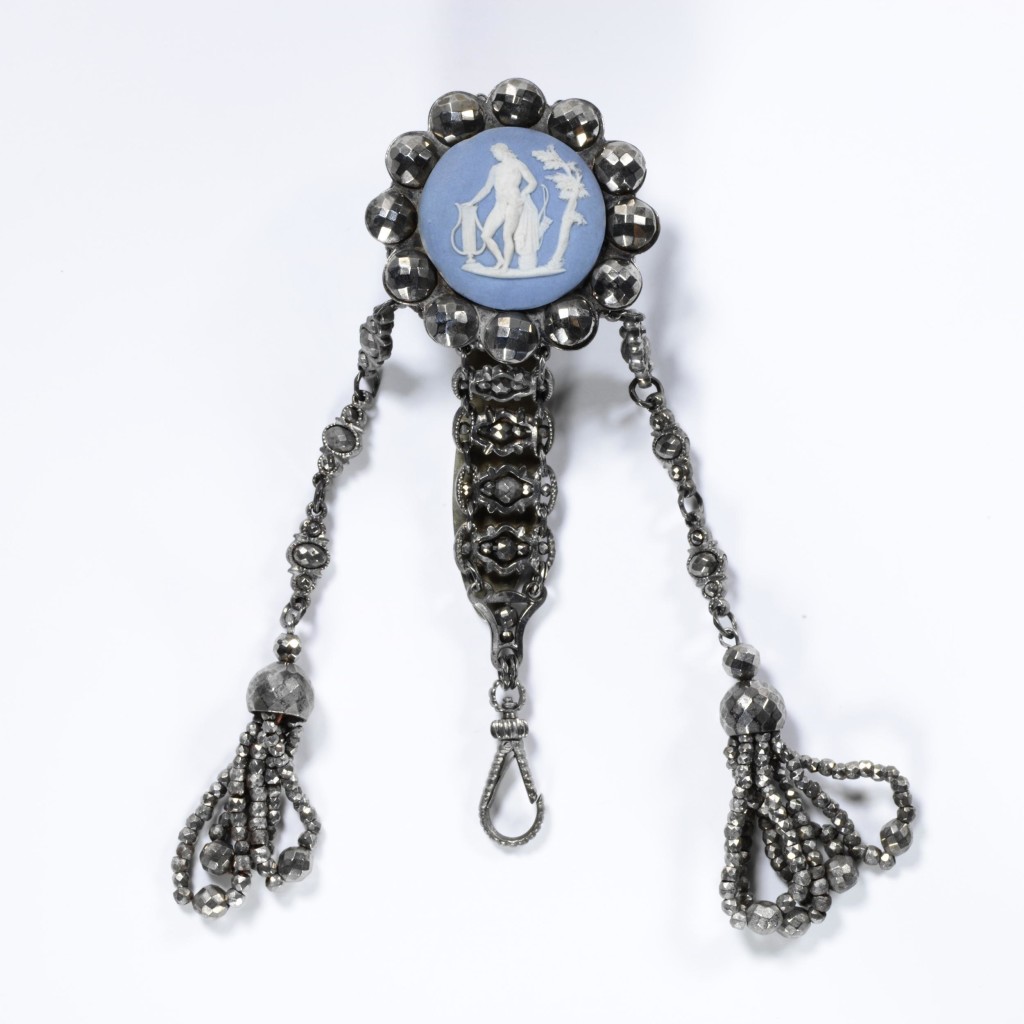
Because it was a decorative and popular style, cut-steel didn’t denote status, it was mixed with popular materials. In the above chatelaine, the jasper ware plaque sits inside dates from 1785-1790 , featuring a fob of Apollo. This chatelaine has many design relations to the sepia chatelaine featured in this article. The fob is the central element to its design, being similar in the oval/round shape. The cut-steel of the fob in the sepia piece is broad and large, much like this around the fob. For dating purposes, the longevity of cut-steel as a material makes the focus of the chain more in the elements that add to it.
In this possibly French example from the early 19th century, the different elements in the trinkets and accessories mark its time and place. Made from cut-steel, it features scrolls (motifs), crown, scissors, buckets (vessels), perfume bottles, cases (containers), knives (cutting tools) and a needle case. Its elements define it and also provide a look at a fully functional chatelaine. This was the literal key to the household, as the chatelaine contained all the elements that could open a house and also hold the elements to describe the wearer. The sentimental benefit here is that it was worn above the clothing, in quite a prominent way, so those who caught its eye could understand the wearer. As Albert Smith had wrote in The Natural History of the Flirt, the chatelaine with its charms were more than simply items of function:
‘There might be a vinaigrette, a desk-key, and a tiny watch, no bigger than a shilling: A pair of scissors like a bird: A horse-shoe against witchcraft; a barrel pincushion, and a pistol pencil. Or, haply, a tumble-case, made like a wise owl, in silver, with enamel eyes: And possibly a heart, a cross and an anchor, typifying Faith, Hope and Charity. Or a paper-cutter. And then, on a ring all to themselves, came little Neapolitan coral charms; comprising, first and foremost, the remedy against an evil eye. And then a boot, a mouse, and a Punch’s head in a slipper: Together with other anomalies. But all these things did to talk about, especially the locket, of which nothing could be leant beyond what a sigh told. And then the young lady found out that the young gentleman also had a locket, hanging from his watchguard, like this; but about it she could learn nothing, for he would not tell.” – Albert Smith, The Natural History of the Flirt
Indeed, the charms and display of them was only popularised in the 19th century through popular figures, such as Queen Victoria. The charms are as important as the chatelaine and become more of token of identity, as much as functionality.
One of the more loving aspects of this chatelaine is the sepia painting and its delicate design. Sepia paintings of the 18th century are known for their brown and red hues, symbolising the body and the earth, along with the integration of hair into the paint. This beautifully depicts the sheaf of wheat painted on ivory, showing three broken stalks and three birds in flight above. On the reverse is a glazed compartment presenting the initials in hair (FJC) on an ivory background.
Wheat has its symbolism baked deeply into the Bread of the Eucharist (Mark 14:22-24), a motif resonant of everlasting life through the belief in Jesus, this is when the motif is bundled with grapes. Within funeral art, we must also consider that wheat within the divine harvest would eventually be reaped (note the link back to the memento mori scythe symbol), denoting the life cut and the renewal (or resurrection) of the soul.
Wheat was a popular motif during a time when jewellery and art symbolism was retreating from heavy ecclesiastical symbolism. Its beauty as a symbol and apparent ambiguity as an appealing symbol makes it one of the symbols to survive the Neoclassical period through to the Gothic Revival and into the Victorian paradigm shift back towards monarchy/church/family values. Thinking that Neoclassical values led to a fundamental reaction against the church would be incorrect. Looking at the Church of England during the Restoration period on through the 19th century, there was a swing towards the importance of the self and though the values of the church were historically being challenged, there wasn’t a movement to challenge the fundamental beliefs. Hence, Neoclassical symbolism interprets much of the traditional Christian motifs into Neoclassical depictions. This is why such a magnificent symbol has lasted through to today in jewellery design. Even at a time when symbolism had reached its zenith as catalogued and indoctrinated in the mid to late 19th century (without the multiple Neoclassical interpretations), wheat was used a prominent symbol. This could be seen even in the high influx of silver pieces post 1880, with wheat flanking a centralised symbol or dedication.
Etched in bracelets, rings, lockets, set in enamel on silver or gold, encrusted with pearls, the wheat sheaf is one of the symbols that lasted into the first quarter of the 20th century on existing memorial jewellery, even when the industry itself was reaching non-existence.
Another reason for its popularity is that the wheat sheaf was one of the simpler and more decorative weaves when table-working hair. as such, it can be found in mourning wreaths, brooches, lockets, rings, woven with gold wire, feathered or simply glued into position. Because of this versatility, wheat became more of a prominent symbol, particularly in the 1820s-60s, in hairwork, rather than a secondary symbol (though it was used for this purpose as well).
All of these elements create a sentimental and loving chain of multiple uses. There is the notion of love and remembrance, the functional aspect of the chain and the use of cut-steel. Its importance in the late 18th century can not be overlooked, as this would be a conversation piece and also the pivot of the household, holding keys and functional items. For the modern collector, what one can see are the elements a of a previous time and its place in the context of fashion. Regardless of how something might function, the level of detail and the construction show something more personal to the wearer, a token of love and one that they would reference several times a day.




